Geology | |
|
Soon after its formation, Mars was bombarded by a myriad of meteors. Energy from the numerous impacts caused the planet to heat up and led to the formation of a semi-liquid mantle and a crust. As the mantle expanded, the crust fractured, and features such as the Tharsis uplift were formed. The Tharsis uplift is an area similar to the Basin and Range Province in western United States, and it is home to several large shield volcanoes. Lava build-up from successive eruptions enabled the formation of these enormous structures that dwarf even the largest volcano on Earth. One reason these volcanoes are so tall is that Mars has only one tectonic plate. It does not experience quakes like Earth does. Each time a volcano erupts, lava spews out and solidifies on previous lava structures. Since there is no surface shifting, nothing impedes the layering of lava, and this results in the large volcanoes we see today. One well-known Martian volcano, Olympus Mons, rises 26km above the surface of Mars. Earth's tallest volcano, Mauna Loa, is a mere 17km from base to summit. | |
Olympus Mons surrounded by clouds Photo Credit: http://www.ucls.uchicago.edu/students/projects/martiansuntimes/images/OlympusMons.jpeg |
A close-up of Olympus Mons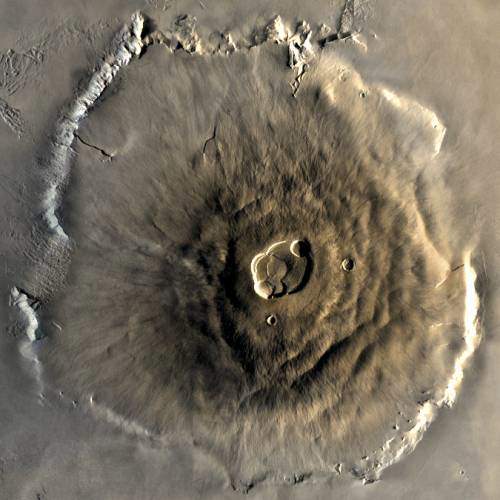 Photo Credit: http://www.harmsy.freeuk.com/images/olympus-mons.jpg |
|
Located in the Tharsis region is the tallest Martian volcano, Nix Olympica. It is 23km tall and 600km wide. It is accompanied by three other large shield volcanoes: North Spot, South Spot, and Middle Spot, each measuring 400km in diameter. These four volcanoes were first discovered during a severe dust storm, when four mountain tops were the only visible features above the dust. Smaller volcanoes also exist on Mars. Dome volcanoes are smaller with steeper slopes, and they are typically around 180km wide at the base and 60km across at the summit pit. Also located along the Tharsis uplift is Valles Marineris, a feature that has been dubbed 'The Grand Canyon of Mars.' It reaches up to 600km wide and 10km deep, making it four times deeper and six times wider than the Grand Canyon on Earth. It stretches almost 4000km long, roughly the length of the United States. It was formed when graben-forming faults cut across a collapsed area that had filled with sediment. Water might have also existed, contributing to landslides that further shaped this enormous trench. | |
Valles Marineris Photo Credit: http://sci.esa.int/science-e-media/img/fb/valles_marineris_01l.jpg | |
|
Volcanic craters also exist in the Tharsis area. They have smooth rims and steep slopes from their rims down to the surrounding terrain, and they have well-defined circular outlines. The smooth rims are what differentiate these craters from impact craters, which have irregular outlines. | |
Tharsis region and volcanoes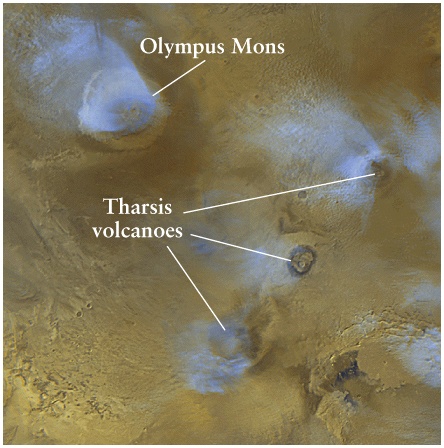 Photo Credit: http://homepage.smc.edu/balm_simon/IMAGES/astro%201b/MARS/tharsis.jpg |
Satellite image of Tharsis region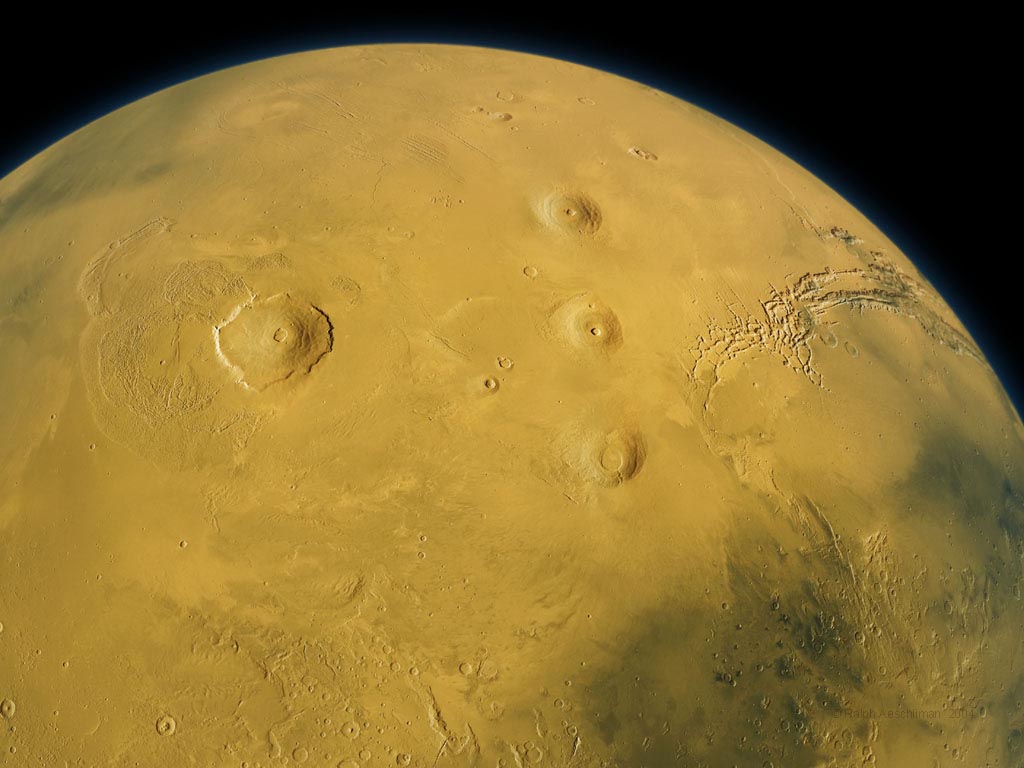 http://ralphaeschliman.com/mars/Tharsis_Solis.jpg |
Topographical map of Tharsis region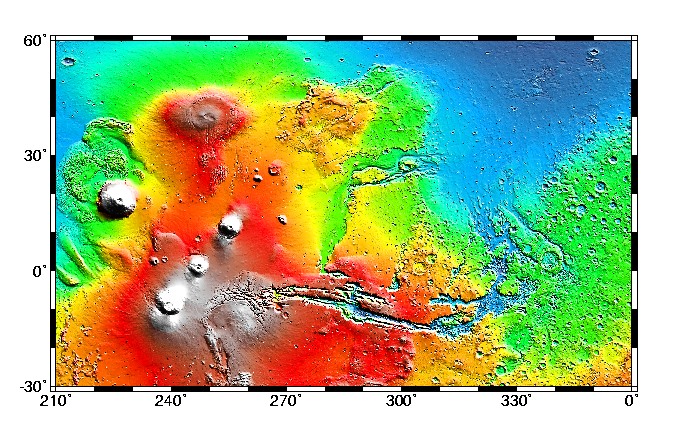 Photo Credit: http://abyss.uoregon.edu/~js/ast121/lectures/tharsis.html | |
Climate | |
|
When the intensity of meteor strikes decreased, Mars developed a warm, dense atmosphere heavy with water vapor. The greenhouse effect took place, keeping Mars warm and wet with lots of heavy rainfall. Erosion was commonplace, and the rain soaked several kilometers into the ground, causing subsurface flows. However, Mars eventually lost its tropical climate. The cooling caused subsurface water to freeze into ground ice. As it froze, pressure increased, and the ice melted, causing extensive flooding. Further cooling froze the water once again and led to the formation of polar ice caps. This was the end of the erosion era almost 2 billion years ago, but there is still the possibility that volcanic activity persisted as recently as a few hundred million years ago. The Mars we see today is dry and dusty, similar to deserts on Earth. It has a very thin atmosphere made mostly of carbon dioxide. Surface pressure is so low that it is below the triple point of water. The pressure ranges from 0.5 - 1% of the surface pressure on Earth. Even if it were warm enough for liquid water to exist, the extremely low pressure would not allow it. Any solid ice would sublimate directly into water vapor. | |
A smooth area of the Martian landscape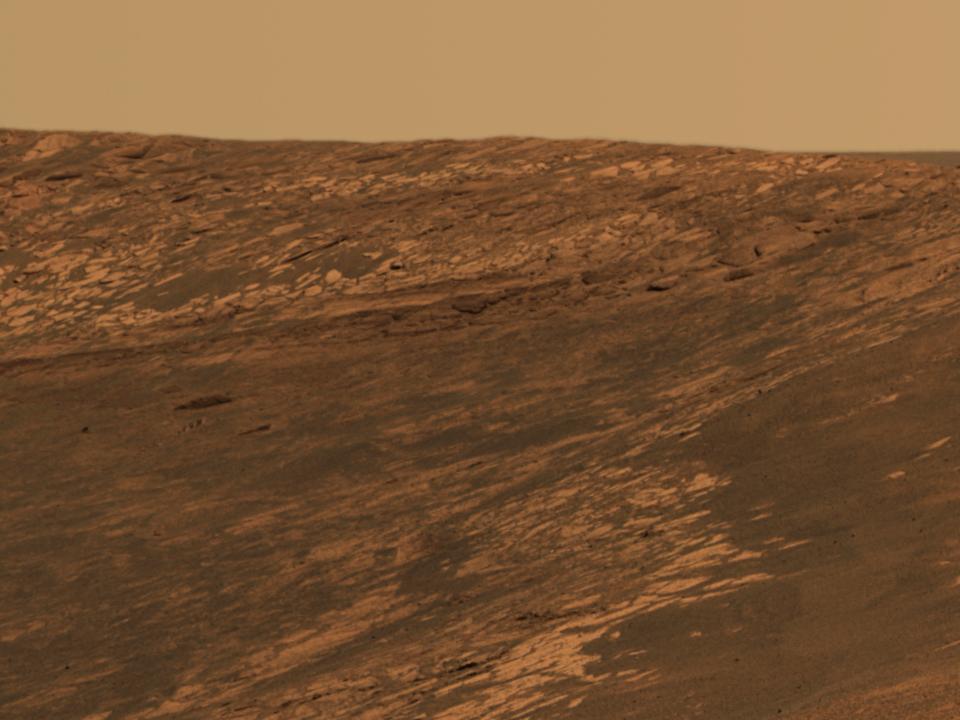 Photo Credit: http://www.universetoday.com/am/uploads/mars.jpg |
Polar ice caps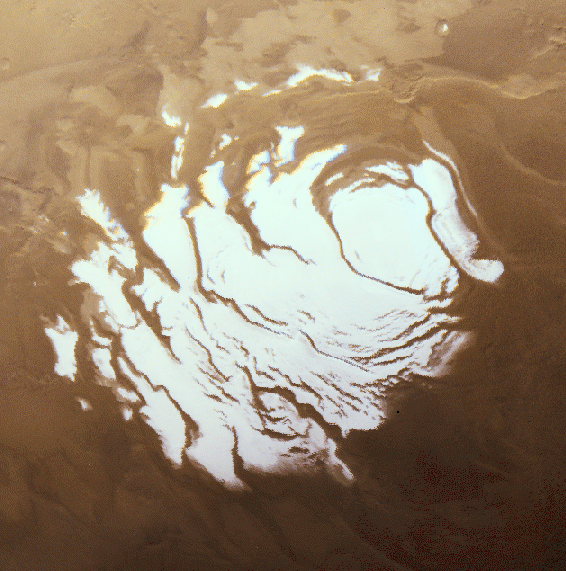 Photo Credit: http://abyss.uoregon.edu/~js/images/southpol.gif |
|
A Martian day, or sol, is only 40 minutes longer than an Earth day. Mars has an axial tilt similar to Earth's 23.5-degree tilt, but its orbit is more elliptical. Because of this, it experiences short, intense Southern summers and Northern winters when it is at perihelion. Northern summers and Southern winters are long and mild by comparison. Even with seasonal variations, there are highly predictable diurnal weather patterns. Surface pressure peaks in mid-morning and reaches a minimum during the Martian evening. It is slightly affected by the carbon dioxide ice caps freezing or sublimating. Freezing draws more carbon dioxide out of the air and decreases surface pressure, while sublimation has the opposite effect. Wind is also fairly predictable, with almost constant, southerly winds blowing at night. It is an established fact that temperature decreases 5-10K for every meter above the surface. This is comparable to a 20F-40F change from head to toe for a person standing on Mars. Dust storms are prominent features on the red planet, and they have a large effect on on atmospheric and surface temperature. On clear days, incident sunlight quickly heats the Martian surface, which in turn heats the atmosphere through radiation and convection. If there is a lot of dust in the air, a lot of the sun's radiation is absorbed before it reaches the ground. The atmosphere heats up while the ground cools, resulting in a negative greenhouse effect. A high dust density will also cause the ground to stay warmer at night, since thicker air traps more of the radiated heat from the surface. Without dust storms present, the average difference between night and day surface temperatures is around 100K. | |
Dust storm on Mars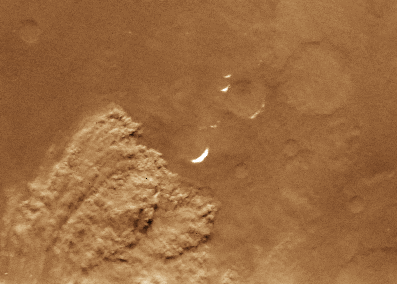 Photo Credit: http://abyss.uoregon.edu/~js/images/mars_dust_storm.gif | |
| Small dust storms are much more frequent than larger storms, and often last no more than 1-2 days. Most occur in regions of low altitude, where the increased atmospheric density makes lifting dust particles easier. The fact that they are short-lived is indicative of the fact that they are transporting larger particles of sand. Small storms sometimes merge to form regional dust storms. These can last up to ten days. More dust is entrained, which leads to more pronounced atmospheric heating and ground cooling. Several regional storms per Martian year can be expected. Even larger storms, which only occur every 2-3 years, can encompass the entire planet. | |
| Back to main page | Next page: Process and Time |